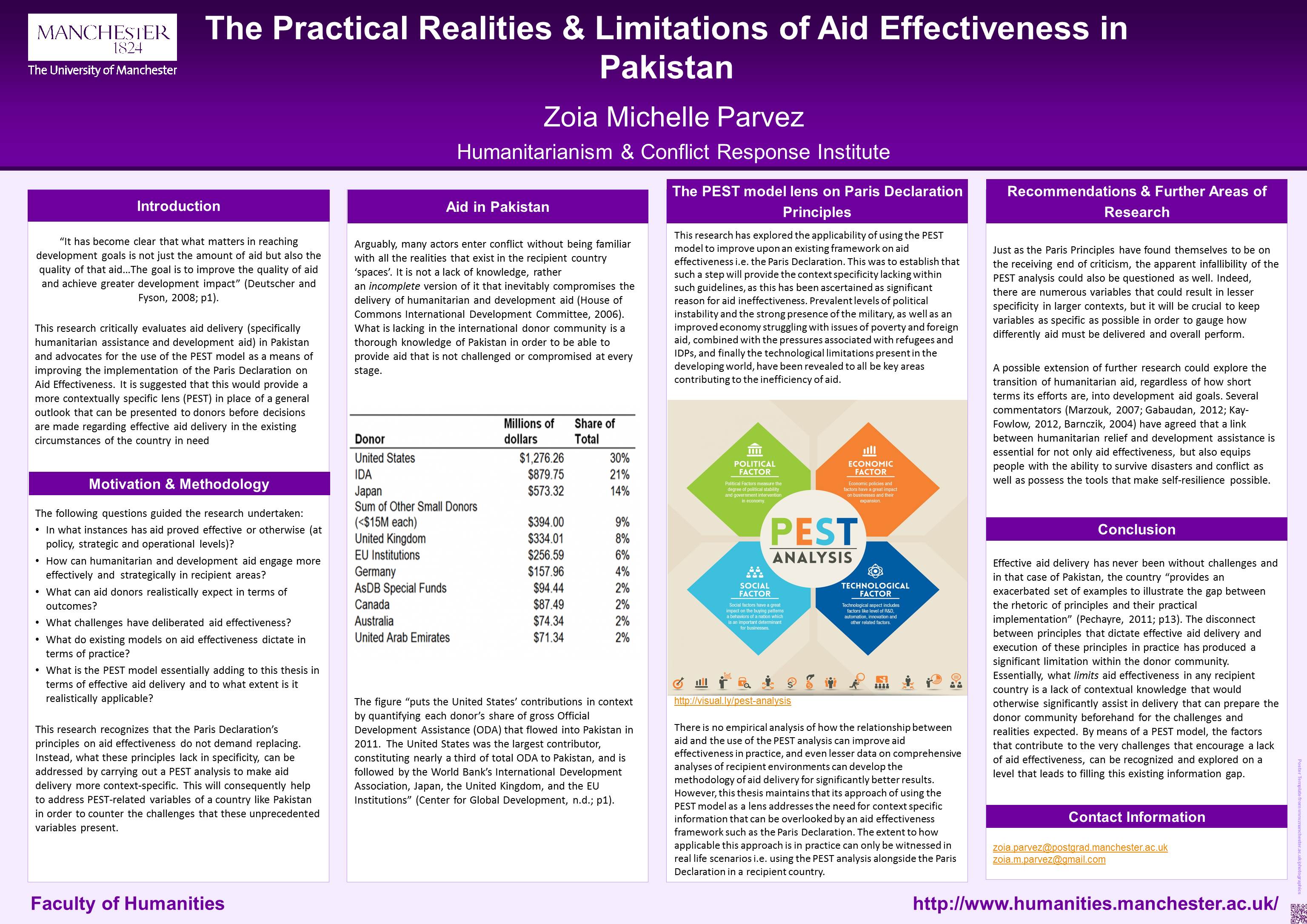The Realities and Practical Limitations of Aid Efficiency in Pakistan Â
Zoia Parvez, @TMZ_Ziggy
 Having recently completed my MA program in Humanitarianism and Conflict Response at the University of Manchester, one of the most rewarding opportunities was being able to present my dissertation, “The Realities and Practical Limitations of Aid Efficiency in Pakistanâ€, as a poster at the International Conference “A Quest for Humanitarian Effectiveness”. This topic is particularly important because the world today is encompassed by economic collapse, climate change and other forms of disasters, and increasingly violent conflicts that threaten the security of civilians and the stability of governments. Humanitarian and development aid are seen as crucial for addressing these issues. Aid delivery must be developed for improved effectiveness and efficiency in recipient nations.
Having recently completed my MA program in Humanitarianism and Conflict Response at the University of Manchester, one of the most rewarding opportunities was being able to present my dissertation, “The Realities and Practical Limitations of Aid Efficiency in Pakistanâ€, as a poster at the International Conference “A Quest for Humanitarian Effectiveness”. This topic is particularly important because the world today is encompassed by economic collapse, climate change and other forms of disasters, and increasingly violent conflicts that threaten the security of civilians and the stability of governments. Humanitarian and development aid are seen as crucial for addressing these issues. Aid delivery must be developed for improved effectiveness and efficiency in recipient nations.
Born and raised in Pakistan, I felt that with my postgraduate and professional humanitarian background, I could do a great deal of more effective work as a humanitarian anywhere else in the world except my own country. Pakistan is included in a pool of aid recipients where the effectiveness of aid delivered has been debated extensively. Â Literature on development aid has been particularly critical of the effectiveness of development and humanitarian aid in Pakistan. This can be accredited to challenges that were usually unforeseen and consequently challenged aid operations. Key areas contributing to the inefficiency of aid in Pakistan include; political instability and a strong military presence, an economy struggling with issues of poverty and foreign aid, pressures associated with refugees and Internally Displaced Persons, and the technological limitations present in the developing world.
The dissertation critically evaluates aid delivery in Pakistan and advocates for the use of the PEST model as a means of improving the implementation of the Paris Declaration on Aid Effectiveness. Using the PEST model, in such a context, is a novel approach as this is a business tool used by marketing professionals when introducing a new product line or service. This tool helps understand the political, economic, social and technological faculties of the target market being entered and how these aspects will affect said product/ service. I proposed that the PEST analysis be used by the humanitarian sector to study the countries (target market) experiencing humanitarian crises and recognize the impact of the political, economic, social and technological indicators on aid delivered (product). This can be applicable to both development aid donors and humanitarian actors.
Essentially, what limits aid effectiveness in any recipient country is a lack of contextual knowledge that would otherwise significantly assist in delivery that can prepare the donor community beforehand for the challenges and realities expected. By means of a PEST model, the factors that contribute to the very challenges that encourage a lack of aid effectiveness, can be recognized and explored on a level that leads to filling this existing information gap. There also exists a need to research further into the relationship between aid practices and the specific environments in which they are to take place.
After my dissertation I realized that I wanted to continue my research in this area. I contacted humanitarians who could aid me in working in South Asian countries to test the efficacy of this research. Thankfully, I have received positive replies of interest from Nepal and Pakistan. This will allow me to continue my research not only in the case of Pakistan (on a more regional level), but also visit the Gorkha district of Nepal as well as other areas to explore the applicability of the PEST model in light of the recent earthquake in particular. My hope is that these projects can encourage me to further pursue more areas of humanitarian research, especially those that focus on addressing existing gaps of aid delivery in Asia-Pacific.



0 Comments